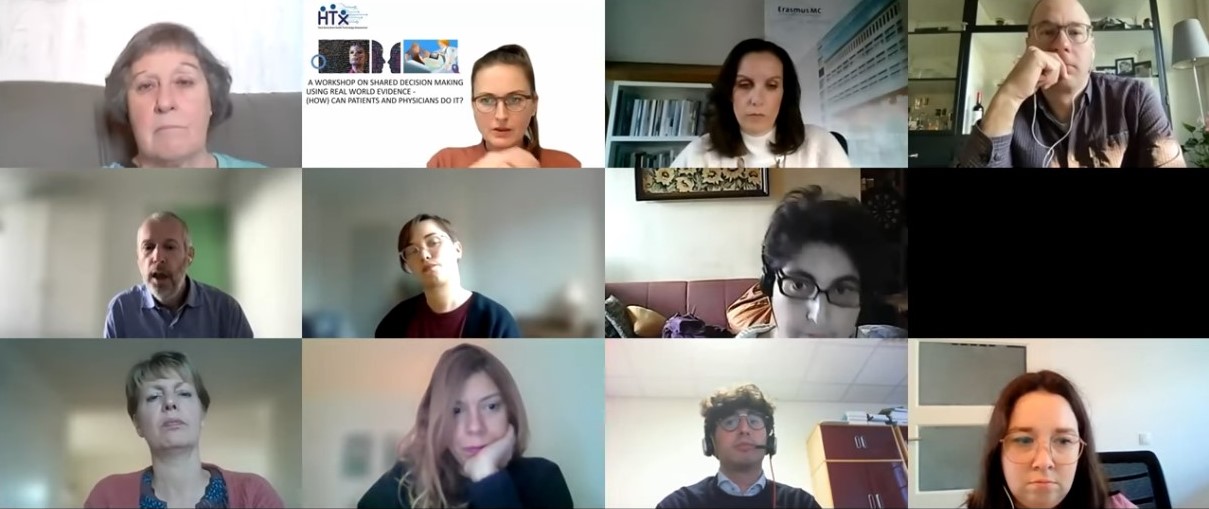
20 Dec Workshop on shared decision making using real-world evidence
On the 29th of November, a digital workshop was hosted from 13:00-17:00 CET. The aim of this workshop was firstly to exchange knowledge from experts on the topics ‘shared decision making’ and ‘real world evidence’. The second aim was to inspire participants by showing examples of developed shared decision-making tools. Thirdly, for the participants to get hands-on experience in thinking about what designing new tools using real-world evidence for shared decision making might entail.
During the first two hours of the workshop, nine speakers shared their experiences. During the second half of the workshop, an interactive session was organized, using Miro boards, to brainstorm and prototype a tool to be used for making shared decisions, using real-world evidence. This interactive part was split into two different disease areas: oncology (which connects to the HTx case study on proton therapy for people with head and neck cancer) and diabetes (which connects to the HTx case study on people with diabetes).
As the first speaker, Wim Goettsch (project leader of HTx) introduced the HTx project and how this Horizon2020 project can contribute to shared decision making (SDM). Then, Holger Schünemann (GRADE) presented the evidence ecosystem and the overlap between HTx, guideline development and SDM. He also made a case to stop using the team ‘real-world evidence’, as it suggests there is also an ‘unreal’ world. Konstantina Chalkou (University of Bern) presented the results of one of the tools developed in HTx: a model to predict the probability of relapse in the next two years for multiple sclerosis patients who receive different treatment options. Individualized outcomes are predicted using prognostic modelling and network meta-analysis. Bringing real-life experiences, Ivett Jakab dove deeper into what shared decision making involves. She emphasized her two take-home messages: (1) empowered patients are the future of healthcare, through a change in attitude and the use of tools, (2) SDM will become the norm. Taking with him a PhD on real-world data, Amr Makady (Johnson & Johnson) talked about what the potential sources of real-world evidence are. Then Marinella Offermans (Erasmus MC) showed that the proof of the pudding is in the eating, and how, at her hospital, outcome data and a health monitor are used in the consultation room for head and neck cancer patients, increasing the quality of care, strengthening the position of patients, and future-proofing healthcare. As the final ‘live’ speaker, Jaivir Pall (International Diabetes Federation) spoke about living with Type 1 Diabetes and shared a story on how he developed a system for controlling and regulating blood glucose: patient-designed technology. Last but not least, Emma Kinloch (National Cancer Research Institute & Salivary Gland Cancer UK) & Pieter van Galen (European Multiple Sclerosis Platform & MS Data Alliance Initiative) – shared their experiences with shared decision making and the importance of involving patients in a prerecorded movie by Eurordis.
You can watch all the presentations here, here and here.
After all the presentations, Céline Dutier, a user experience (UX) design researcher and AI designer hosted an interactive workshop. After an introduction to two HTx case studies by Lifang Liu (head and neck cancer) and Gema García Saèz (diabetes), Céline presented nine design challenges that must be addressed when working on systems that support clinical decision-making. In small groups, participants thought about these challenges and came up with possible solutions when designing tools for shared decision making, using real-world evidence and AI. [1]
[1] Piet N. (2021-12-03). UX challenges for AI/ML products [1/3]: Trust & Transparency. Design considerations in Human-AI interactions. Part 1 of the series. Medium.com.
